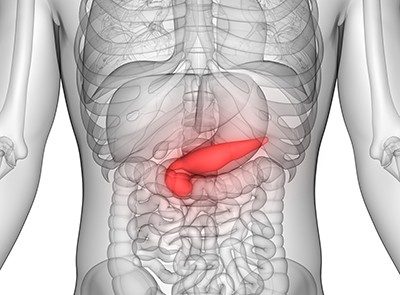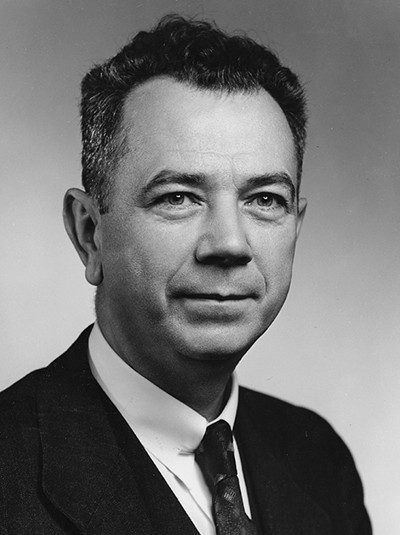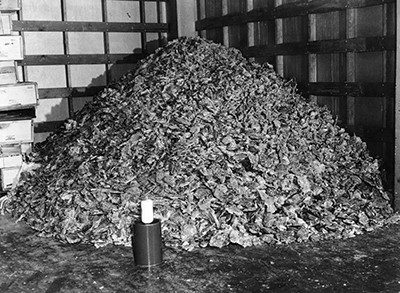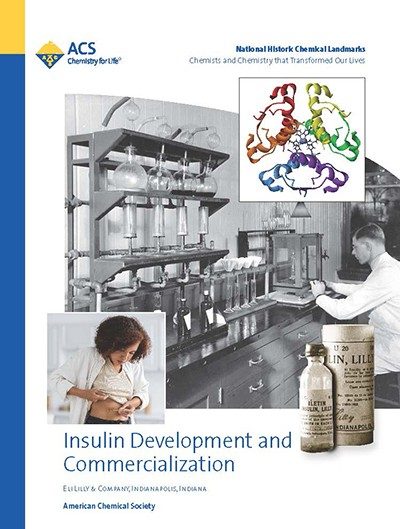Insulin Development and Commercialization
Dedicated at the Eugene and Marilyn Glick Indiana History Center on March 27, 2023
In December 1921, 14-year-old Leonard Thompson was near death. The boy had diabetes and weighed just 65 pounds. After a month in Toronto General Hospital, he wasn’t improving, so his physicians turned to an experimental treatment under development by Canadian researchers. In January 1922, the doctors cautiously injected Thompson with pancreatic fluid extracted from cows. The scientific and medical understanding of diabetes was murky at the time, but advancing rapidly. By injecting the boy, the team hoped to confirm what they had already seen in animals: Something extracted from a healthy pancreas regulates blood sugar. And scientists already had a name for this mysterious something: insulin. As it turned out, the injection saved Thompson’s life, marking a turning point in the treatment of a condition that had been, until then, a virtual death sentence.
Diabetes is a chronic disease that disrupts how the body metabolizes blood sugar. Normally, a rise in blood sugar signals the pancreas to release insulin. But in one form of diabetes, type 1, we now know that the pancreas produces little or no insulin; in type 2, the pancreas may produce insulin, but the body can’t use it effectively. In either case, the body’s glucose levels rise, eventually leading to dangerous circulatory, nervous, and immune system problems.
In turn, that can result in blindness, kidney or heart failure, or stroke. And despite the advances since Thompson’s time, diabetes is still the ninth leading cause of death worldwide, with 1.5 million people succumbing to the disease in 2019. The global burden of diabetes is mounting: There were 108 million people living with diabetes in 1980, but that number ballooned to 422 million by 2014, according to the World Health Organization.
Yet, for those with access to insulin, diabetes is now a largely manageable condition. Pharmacological researchers continue to demystify diabetes. They have learned to understand the nature of the disease, how to control it, and how to prepare and refine treatments. In so doing, they have saved millions of lives, and that story of success and sustained improvement continues today.
Contents



Early history
The recorded history of diabetes stretches back 3,500 years to an Egyptian papyrus on which physician Hesy-Ra documented a condition of “frequent urination.” We now know that when kidneys can’t filter enough excess glucose from blood, they release more sugary fluids into the urine. Additional insight was obtained in 1675, when British physician Thomas Willis tasted the urine of his patients. If their urine tasted sweet, he diagnosed them with diabetes mellitus (meaning honeyed). One of today’s tests still checks the sugar level in urine, but no longer relies on tasting it.
Nearly 200 years later, in 1869, German medical student Paul Langerhans noticed that the pancreas contains “islands” of a distinctive type of cell, though he didn’t know their function. A few decades later, researchers showed that removing the pancreas from a dog induced diabetes. They concluded that the pancreas produces a substance necessary to metabolize sugar.
In 1909, the term insulin was introduced. Derived from the Latin word for island, insulin referred to the hypothetical substance produced by Langerhans’s pancreatic “island” cells. Some of the first evidence supporting the insulin theory was that Langerhans’s cells were found to be destroyed in people with type 1 diabetes.
Then, in 1916, Romanian physiologist Nicolas Paulescu of the University of Bucharest showed that an extract of pancreatic cells lowered blood sugar in diabetic dogs. Other researchers worked on extracts as well, but attempts to extract insulin seemed to either destroy the active substance or contaminate the product with toxic impurities, preventing use of this potentially lifesaving treatment in people.
These challenges inspired Canadian physician Frederick Banting to conduct his own experiments beginning in 1921. He worked with Charles Best and James Collip, guided by University of Toronto physiology professor John James Rickard Macleod. The team invented a process to coax an extract out of pancreas cells and purify it as insulin. One of their key advances involved extraction with about 90% alcohol, which selectively dissolved insulin so it could be separated from some of the impurities.
After successful testing of insulin injections in dogs and rabbits, the treatment was ready for human trials, beginning with Leonard Thompson in January 1922. The experiment lowered his blood sugar to near normal levels and saved his life.
The University of Toronto team refined their production process by first extracting pancreatic tissue in slightly acidified acetone, followed by alcohol extraction.
Physicians who heard about the new wonder drug were clamoring for insulin to save their dying patients, but the university was unable to produce significant quantities. In May 1922, pharmaceutical company Eli Lilly & Company began collaborating with the university to scale up and commercialize production of insulin in the Americas. The effort was led by Lilly chemist George Walden. By July, the firm shipped its first batches of Iletin® insulin for clinical testing.
Almost overnight, the animal pancreas extract treatment changed diabetes from a lethal condition. Thompson lived to the age of 26. Other children from those early years of groundbreaking treatment lived even longer. Elizabeth Hughes, one of the first people Banting treated with insulin, died at the age of 73, having received approximately 42,000 insulin injections over 58 years.
In 1923, the year after the clinical trial, Banting and Macleod received a Nobel Prize for the discovery of insulin.
Insulin’s impact was so sensational because of the incredible effect it had on diabetic patients. Those who watched the first starved, sometimes comatose, diabetics receive insulin and return to life saw one of the genuine miracles of modern medicine."
— Michael Bliss, The Discovery of Insulin: Special Centenary Edition, 2021

Since 1922, insulin has made the difference between life and death for millions of people with diabetes.”
— Alison Li, The Discovery of Insulin: Special Centenary Edition, 2021

Industrial insulin
Mass production of insulin extracted from animals began in the wake of successful clinical trials in Toronto and elsewhere in 1922. In addition to Lilly, others began to produce insulin, including the nonprofit Nordisk Insulin Laboratory (which later became Novo Nordisk) and Hoechst AG (a predecessor of Sanofi).
The ability to make a pure, reproducible product was of paramount importance to pharmaceutical companies looking to scale up, and early trials signaled to physicians that the purity of the extract influenced patient outcome. So, chemists sought to develop new methods to purify the “miracle drug.”
One milestone was reached thanks to an advance in a technique known as isoelectric precipitation, discovered independently at Lilly and at Washington University in St. Louis. Pancreas extracts contain many different proteins, each with different molecular sizes, chemical properties, and electrostatic charges. Adjusting the pH of a solution containing the mixture changes the charge on those proteins, with different types of proteins responding at different pH. At a given pH, certain proteins become neutral, causing them to precipitate out of solution for easy isolation, while unwanted contaminants remain dissolved. In 1923, Lilly began full-scale animal insulin production based on this separation technique. This revolutionized the purity and stability of the final product, paving the way for mass production.
Over the following decades, researchers learned more about the still mysterious extract. Insulin had long been considered to be a cocktail of proteins. But beginning in 1924, evidence emerged that insulin might be a single protein. Scientists from Johns Hopkins University proved that hypothesis in 1935.
Then, between 1951 and 1955, English biochemist Frederick Sanger determined the sequence of amino acids for that single protein. These discoveries influenced how the world thinks about insulin. And, perhaps more profoundly, the discoveries stimulated scientists to imagine how they might purify and even create it themselves.

Eli Lilly became the first manufacturer to mass produce insulin and in October 1923 they began shipping the first commercial supply.”
— 100 Years of Insulin, The British Diabetic Association

Modernizing insulin
Viewing insulin as a single chemical entity rather than a heterogenous extract proved essential for radically improving its potential as a drug. Scientists could apply rules from chemistry to better purify the insulin molecule.
Pharmaceutical companies began reaching 80 to 90% purity by the 1970s using techniques such as chromatography. More fundamentally, they also had the tools to determine the exact structure of the insulin molecules. For example, researchers learned insulin consists of two long chains of amino acids (polypeptide chains), dubbed A and B, linked by “bridges” containing sulfur. But not all insulin is equal. Human insulin differs from cow insulin, which differs from pig insulin. Each has largely equivalent chains of amino acid building blocks, with a few changes setting them apart.
Until the 1980s, doctors treated diabetes in humans with insulin sourced from animals — primarily pigs and cows. But on the heels of a nascent biotech revolution, that too began to change as manufacturers sought to avoid the allergenic potential of these animal products. DNA-editing experts at Genentech partnered with Lilly to develop a new process that used microbes to produce insulin. Think of any microbial cell as a sort of protein factory: Each cell naturally manufactures proteins based on instructions written in its DNA. Drug chemists knew what protein they wanted, down to the individual amino acid building block, and their new tools made it possible to stitch tailored genetic instructions into the DNA blueprints of microbes.
The collaborators used this “recombinant DNA” process to produce human insulin from bacteria with 98% purity. And in 1982, the Food and Drug Administration approved the resultant drug, Humulin®, the first FDA-approved recombinant drug of any kind.
Humulin’s success made a strong case for genetic engineering’s new role in pharmaceutical chemistry: Chemists now had near-total control over the amino acid sequence of their products, and they could reach higher purities. This opened the door for scientists looking to tinker, tweak, and tune the still-imperfect drug.


Analog future
A protein’s function depends on its chemical makeup. The size, charge, and type of elements linked within each amino acid influence key protein properties that affect pharmaceutical traits: how cells process the drug, how stable the molecule is, and how potent it is. So, armed with the additional tailoring tools of genetic engineering, drug researchers began inventing insulin “analogs,” variations of the natural insulin protein, meant to supercharge performance.
Supercharging, in this case, means more than just increasing potency. It’s also a way around a dosing issue. If a person’s dose of insulin is too low, they won’t receive enough benefit. If their dose is too high, the excess insulin risks removing too much blood glucose and making a person dangerously hypoglycemic. The “window” for natural insulin’s therapeutic dosage is uncomfortably narrow.
To circumvent dosage issues, scientists tuned insulin’s structure by tinkering with the protein’s individual amino acids. This is done by swapping the order of a few of the amino acids, or adding or deleting some, rather like altering the beads in a necklace. Swapping the order changes the characteristics of the insulin. For instance, lispro, an analog made by Lilly, breaks down from large complexes to small subunits more rapidly than normal insulin, which means it becomes available to cells faster (see box). Faster availability, which is useful for a mealtime dose, reduces the likelihood of hypoglycemia caused by lingering insulin. Novo Nordisk’s insulin aspart is based on a similar principle.
A different approach involves changing a few amino acids to make more stable and long-lasting analogs for once-daily basal insulin use. Novo Nordisk created insulin degludec with this approach, while Aventis (which became part of Sanofi) used it to make insulin glargine. The subtle changes in degludec and glargine make the molecules less soluble, so they dissolve into the bloodstream slowly without causing quick spikes in insulin levels.
The overarching goal is to have more insulin in the blood when it is needed, and less when it is not. Researchers from drug companies and startups are now thinking beyond molecular makeup and genetic engineering. Some have looked toward technologies like microneedles to solve the dosage problem.
A Massachusetts Institute of Technology lab, led by Robert Langer, who is working with Novo Nordisk, created ingestible microneedles to provide insulin orally. The tiny array of needles painlessly delivers insulin into the stomach lining. These microneedles increase bioavailability of oral insulin to 50%, whereas only 10% of the ingested insulin makes it into the bloodstream when taken by mouth.
Microneedles can help get insulin in through the skin, too. Researchers at Zhejiang University in China have developed a patch the size of a coin that can respond to glucose levels. The insulin-filled patch contains polymeric needles and phenylboronic acid. As blood sugar rises, the phenylboronic acid reacts chemically with glucose — swelling the microneedles and releasing insulin. Zhen Gu, who leads the project, envisions people with diabetes applying patches before meals.
The International Diabetes Federation estimates that globally 537 million adults currently live with diabetes. For those who can access and afford insulin, it is a literal lifesaver, saving tens of millions of lives over the past 100 years. But what’s fascinating is that this gamechanger keeps changing. Scientific advances in fields like synthetic biology (for recombinant DNA) and materials chemistry (for microneedle delivery) have elevated the healing prospect of insulin. The rich story of biochemical inventions continues as scientists seek to perfect their miracle drug.


What does a dose of insulin do?
The insulin hormone regulates blood concentrations of glucose, the sugar the body produces when digesting food. Because the body metabolizes insulin, it must regularly replenish it, either via the pancreas or, in the case of people with diabetes, by injection.
In the pancreas and in injections for people with diabetes, insulin is in an inactive form called a hexamer. At the molecular level, a hexamer of insulin is a sphere of six insulin molecules joined together (see adjacent image). Cells do not respond to insulin in this large, coordinated form. But in the body, the insulin hexamer naturally breaks down into its components, or monomers. (That’s why mealtime insulin analogs are more fast acting — they get to the monomer form faster.) Monomers of insulin bind to protein receptors on the outside of cells, inducing a structural change that propagates across the membrane. This cascading effect tells cells to take in more glucose — thereby reducing levels of glucose circulating in the bloodstream.

Landmark dedication and acknowledgments
Landmark dedication
The American Chemical Society (ACS) honored the development and commercialization of insulin with the National Historic Chemical Landmark (NHCL) designation in a ceremony at the Eugene and Marilyn Glick Indiana History Center on March 27, 2023. The commemorative plaque reads:
Diabetes used to be invariably fatal, killing people by disrupting sugar metabolism. But in 1922, University of Toronto researchers and doctors successfully treated a boy who had diabetes. They injected him with insulin extracted from animal pancreases, thereby saving his life. Physicians clamored for the new drug, but the university couldn’t meet demand. Eli Lilly & Company scaled up production in collaboration with the university, delivering the first commercial doses in 1923. Collaboration and licensing agreements allowed additional companies to supply insulin. Innovations followed, such as increasing purity to improve tolerance, using microbes for production, and creating beneficial analogs. Millions have been treated with insulin since the 1920s, and diabetes is no longer a death sentence.
Acknowledgments
Written by Max Levy.
The author wishes to thank contributors to and reviewers of this booklet, all of whom helped improve its content, especially members of the ACS NHCL Subcommittee.
The nomination for this Landmark designation was prepared by the Indiana Local Section of the ACS.

Booklet PDF
Additonal resources
Further reading
- The Discovery of Insulin (The Canadian Encyclopedia)
- The Discovery of Insulin (book by Michael Bliss)
- 100 Years of Insulin (Lilly)
- Insulin Manufacturing Over The Last 100 Years (Lilly video)
- Diabetes Fact Sheet (World Health Organization)
- Diabetes Atlas (International Diabetes Federation)
- Blood Sugar and Insulin at Work (American Diabetes Association)
- Diabetes treatment: Using insulin to manage blood sugar (Mayo Clinic)
- You and Your Hormones: Insulin (Society for Endocrinology)
- The Evolution of Insulin and How it Informs Therapy and Treatment Choices (Oxford University Press)
- Al and Helen Free and the Development of Diagnostic Test Strips (ACS)
- Carl and Gerty Cori and Carbohydrate Metabolism (ACS)

